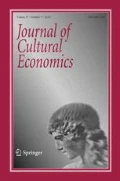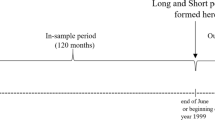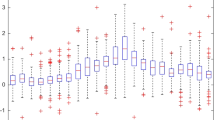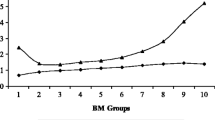Abstract
We analyze long-term art auction sales data focusing on and around financial crisis periods with other investment returns to understand whether art can be considered a safe haven during volatile times or a hedging option in general by analyzing art auction data in a volatile emerging market. Our findings suggest Turkish art returns are either negatively correlated or at low correlation with other investments, including the equity market. We have the view that art can be considered a hedging mechanism on average to enhance returns and to decrease the risk of portfolios and improve diversification. However, we do not discard the safe-haven hypothesis, either. Although the auction data on the crisis period is limited, results of and around crisis periods show art returns are positively correlated with various volatility indices. In addition, the number of art transactions also increases after the crisis years, which may be a sign of liquidity requirement of some investors and an opportunity for buyers. The benefit is visible especially during years of contractions, which do not end with a very severe crisis, since the art auction market liquidity dries if the crisis is severe.


Similar content being viewed by others
Notes
Deloitte 2017 report on Art and Finance estimated the assets under management at $1 billion in 2016. Deloitte 2017 report on Art and Finance pointed out that there has been a shift in the primary focus on art investment toward issues around the management of art-related wealth, including art-secured lending, estate planning, art advisory, and risk management and that within the next decade more wealth is expected to be invested in art globally. Deloitte Art and Finance Report, 2017, 5th edition.
Credit Suisse Global Wealth Report 2018. https://www.credit-suisse.com/corporate/en/research/research-institute/global-wealth-report.htm. Accessed on May 1, 2019.
An important example for the initial demand of quality art works in the USA is John Pierpont Morgan, who started to collect art from 1890s to 1913, including collections from Sir James Fenn (English autographs) and Charles Fairfax Murray as the first classic collection of master drawings, spending $60 million with the purchasing power of $900 million today for a wide coverage collection of art. He quoted: “No price is too high for an object of unquestioned beauty and known authenticity.” This collection now has reached more than 30,000 items traveling through exhibitions or the offices of JP Morgan in the world.
Credit Suisse Global Wealth Report 2018. https://www.credit-suisse.com/corporate/en/research/research-institute/global-wealth-report.htm. Accessed on May 1, 2019.
http://www.arter.org.tr/W3/?sAction=Arter. About an affiliate of the Vehbi Koç Foundation (VKF), Arter was opened in 2010 with the aim of providing a sustainable infrastructure for producing and exhibiting contemporary art.
https://www.world-exchanges.org/our-work/statistics. Accessed on June 13, 2019.
The explanation can be that wealthy investors continue to purchase houses, and they might consider housing a safe investment.
Cboe Global Markets revolutionized investing with the creation of the Cboe Volatility Index® (VIX® Index), the first benchmark index to measure the market’s expectation of future volatility. The VIX Index is based on options of the S&P 500® Index, considered the leading indicator of the broad US stock market. The VIX Index is recognized as the world’s premier gauge of US equity market volatility. Source: http://www.cboe.com/vix.
We borrow the “fire sales” terminology from finance literature [see, for example, Shleifer and Vishny (2011)].
Buelens and Ginsburgh (1993) argue that the findings of Baumol (1986) are overly pessimistic; and using the same data set, they calculate a significantly higher return for art than stocks and bonds within certain segments of the market (subperiods and different schools), especially for 20–40-year periods.
Others like Campbell (2008) and Burton and Jacobsen (1999) conduct an extensive review of the methodologies used and the interpretations for financial returns to investing in various types of collectibles. Several studies of art focus on Picasso as a master of art (Czujack 1997; Pesando and Shum 2007; Biey and Zanola 2005).
Art has high transaction costs. The transaction costs in the US can be up to 35% where the seller pays 5–10%, and buyer pays 12–25% (Burton and Jacobsen 1999). Indeed, the calculation of art returns is difficult as art is less transparent with high information asymmetry than other financial assets; and there is no regulated art exchange. Another factor affecting the sale of artworks is the difference between the reservation price of the investor and the actual sales price. Using data from contemporary art auctions, Ashenfelter and Graddy (2011) estimate that the confidential reserve price to be set at approximately 70% of the low estimate. Additionally, the liquidity of artworks is lower compared to many financial assets; and art is not a standard exchange traded financial asset. Another important difficulty in investing in art is that the preferences are subject to different tastes and cultures, and they are also subject to political stability, economic conditions, and are time variant. Moreover, art has many constituents, and there are both supply and demand sides. Finally, the art market is evolving very fast, and change of trends in art is another important fact. The religious icons, impressionist paintings, contemporary art, pop art, op art, video art, installations are all different approaches and trends in the art arena. Another area of importance is the authenticity of art works, which is extremely important and an issue for court cases. The provenance arises as an important measure for authenticity. We observe opportunistic behavior of use of art in some examples of theft, fake paintings, fraud, money laundering and drug smuggling as well as barters in artwork. The art market’s opaque nature and the need and demand for protection by experts against lawsuits makes art market vulnerable to forgery (Ekelund et al. 2017).
The global financial crisis of 2009 did not have an effect on the economy, like in 1994 and 2001 thanks to the institutionalization and regulation of the financial sector in 2001. Similarly, the Asian currency crisis of 1997 did not have a long lasting effect on the Turkish markets.
Information provided by the auction house Rafi Portakal (April 3, 2019). The dates for these were November 2015, January 2017, April–May 2017, December 2017, April 2018, September 2018, and November–December 2018.
A CDS is defined as an insurance contract against losses incurred by creditors in the event that a debtor defaults on its debt obligations. As in a swap, as part of the contract, the protection buyer pays a premium (the CDS premium) to the protection seller, in exchange for a payment from the protection seller to the protection buyer if a credit event occurs on a reference credit instrument within a predetermined time period. Common credit events are bankruptcy, failure to pay, and, in some CDS contracts, debt restructuring or a credit-rating downgrade. As explained in Cornett et al. (2014) when the market perceives that the probability of a debt default decreases (increases), the spread charged on the CDS decreases (increases). CDS spreads have been widely used in the literature to measure credit risk as some argue that CDS spreads are a pure measure of credit risk as well as its relationship with equity volatility or implied volatility (Longstaff et al. 2005; Callen et al. 2009; Campbell and Taksler 2003; Zhang et al. 2009).
Charlin and Cifuentes (2017) suggest that relying on point estimates from hedonic regressions on auctions may be misleading. As a result, they provide a log transformation followed by a wild bootstrap method correction.
Information provided by the auction house, Rafi Portakal (April 3, 2019).
In untabulated results, we first calculate the indices based on our hedonic regressions as the exponential of the year dummy from the specification used in Seçkin and Atukeren (2006) to compare our results with prior findings. We find that for the years where our data overlaps, returns are quite close to our findings in terms of arithmetic averages. However, year by year, results differ. We believe that there may be two sources for the differences. Our data set allows us to include more explanatory variables with a longer data period, and is a larger data set. As a result, our specification might capture the variation in sales prices better, and is less likely to suffer from the omitted variable bias of the estimated index although we do not suggest that we capture all the available characteristics.
In hedonic regressions, if one uses a model with a logarithmic dependent variable, the time dummy hedonic index can be calculated as the ratio of the geometric average of two period prices adjusted for the difference in painting characteristics. In fact, the referenced research (Triplett and McDonald 1977) shows that the index from using pure time dummies versus calculating the ratio of geometric prices adjusted by mean characteristic differences should be similar.
References
Agnello, R. J., & Pierce, R. K. (1996). Financial returns, price determinants, and genre effects in American art investment. Journal of Cultural Economics,20, 359–383.
Agyei-Ampomah, S., Gounopoulos, D., & Mazouz, K. (2014). Does gold offer a better protection against losses in sovereign debt bonds than other metals? Journal of Banking and Finance,40(1), 507–521. https://doi.org/10.1016/j.jbankfin.2013.11.014.
Anderson, R. (1974). Paintings as an investment. Economic Inquiry,12(1), 13–26.
Ashenfelter, O., & Graddy, K. (2011). Sale rates and price movements in art auctions. American Economic Review,101(3), 212–216. https://doi.org/10.1257/aer.101.3.212.
Atkinson, T. (2015). What can be done about inequality. Juncture,22(1), 32–41.
Atukeren, E., & Seçkin, A. (2009). An analysis of the price dynamics between the Turkish and the international paintings markets. Applied Financial Economics,19(21), 1705–1714. https://doi.org/10.1080/09603100903018737.
Baum, C., Caglayan, M., & Talavera, O. (2010). Parliamentary election cycles and the Turkish banking sector. Journal of Banking and Finance,34(11), 2709–2719.
Baumol, W. J. (1986). Unnatural value: Or art investment as floating crap game. The American Economic Review,76(2), 10–14.
Baur, D. G., & Lucey, B. M. (2010). Is gold a hedge or a safe haven? An analysis of stocks, bonds and gold. Financial Review,45(2), 217–229. https://doi.org/10.1111/j.1540-6288.2010.00244.x.
Baur, D. G., & McDermott, Thomas K. J. (2016). Why is gold a safe haven? Journal of Behavioral and Experimental Finance,10, 63–71. https://doi.org/10.1016/j.jbef.2016.03.002.
Biey, M. L., & Zanola, R. (2005). The market for Picasso prints: An hybrid model approach. Journal of Cultural Economics,29, 127–136.
Buelens, N., & Ginsburgh, V. (1993). Revisiting Baumol’s “Art as floating crap game”. European Economic Review,37, 1351–1371.
Burton, B. J., & Jacobsen, J. P. (1999). Measuring returns on investments in collectibles. Journal of Economic Perspectives,13(4), 193–212. https://doi.org/10.1257/jep.13.4.193.
Callen, J. L., Livnat, J., & Segal, D. (2009). The impact of earnings on the pricing of credit default swaps. Accounting Review,84(5), 1363–1394. https://doi.org/10.2308/accr.2009.84.5.1363.
Campbell, J. Y., & Taksler, G. B. (2003). Equity volatility and corporate bond yields. Journal of Finance,58(6), 2321–2349. https://doi.org/10.1046/j.1540-6261.2003.00607.x.
Campbell, R. A. J. (2008). Art as a financial investment. The Journal of Alternative Investments,10(4), 64–81.
Campos, N. F., & Barbosa, R. L. (2008). Paintings and numbers: An econometric investigation of sales rates, prices and returns in Latin American art auctions. IZA discussion papers, no. 3445.
Case, B., & Quigley, J. (1991). The dynamics of real estate prices. The Review of Economics and Statistics,73, 50–58.
Ceritoglu, E. (2017). The effect of house price changes on cohort consumption in Turkey. Central Bank Review,17, 99–110.
Chanel, O., Gerard-Varet, L.-A., & Ginsburgh, V. (1996). The relevance of hedonic price indices: The case of paintings. Journal of Cultural Economics,20(1), 1–24.
Charlin, V., & Cifuentes, A. (2017). On the uncertainty of art market returns. Finance Research Letters,21, 186–189. https://doi.org/10.1016/j.frl.2016.12.005.
Choudhry, T., Hassan, S. S., & Shabi, S. (2015). Relationship between gold and stock markets during the global financial crisis: Evidence from nonlinear causality tests. International Review of Financial Analysis,41, 247–256. https://doi.org/10.1016/j.irfa.2015.03.011.
Comert, H., & Yeldan, E. (2018). A tale of three crises in Turkey: 1994, 2001 and 2008–09. ERC working papers 1809, ERC—Economic Research Center, Middle East Technical University.
Cornett, M. M., Mehran, H., Pan, K., Phan, M., & Wei, C. (2014). CDS and equity market reactions to stock issuances in the US financial industry: Evidence from the 2002–13 period. Federal Reserve Bank of New York Staff Reports N. 697 (November).
Credit Suisse Global Wealth Report. (2018).
Czujack, C. (1997). Picasso paintings at auction, 1963–1994. Journal of Cultural Economics,21(1971), 229–247.
David, G. (2014). Is art really a safe heaven? Evidence from the French art market during WWI. Working paper (Vol. 32).
De la Barre, M., Sophie, D., & Ginsburgh, V. (1994). Returns of impressionist, and contemporary paintings European modern. Annaless d’Economie et de Statistique,35(35), 143–181.
Dixit, A., & Pindyck, R. (1994). Investment under uncertainty. Princeton, NJ: Princeton University Press.
Edwards, S. (2004). The economics of Latin American Art: Creativity patterns and rates of return. Economia,4, 1–36.
Eurostat. (2011). Handbook on residential property prices indexes. http://epp.eurostat.ec.europa.eu/portal/page/portal/hicp/methodology/owner_occupied_housing_hpi/rppi_handbook.
Ferguson, H. (2011). A moveable empire: Ottoman nomads, migrants & refugees. Seattle: University of Washington Press.
Ginsburgh, V., Mei, J., & Moses, M. (2006). Chapter 27 the computation of prices indices. Handbook of the Economics of Art and Culture,1(06), 947–979. https://doi.org/10.1016/S1574-0676(06)01027-1.
Goetzmann, W. N. (1993). Accounting for taste: Art and the financial markets over three centuries. The American Economic Review,83(5), 1370–1376.
Higgs, H. (2012). Australian art market prices during the global financial crisis and two earlier decades. Australian Economic Papers,51(4), 189–209.
Hodgson, D. J. (2011). An analysis of pricing and returns in the market for French Canadian paintings. Applied Economics,43(1), 63–73.
Hodgson, D. J., & Seçkin, A. (2012). Dynamic price dependence of Canadian and international art markets: An empirical analysis. Empirical Economics,43, 867–890. https://doi.org/10.1007/s00181-011-0502-z.
Hodgson, D. J., & Vorkink, K. P. (2004). Asset pricing theory and the valuation of Canadian paintings. Canadian Journal of Economics/Revue canadienne d’économique,37(3), 629–655.
Iqbal, J. (2017). Does gold hedge stock market, inflation and exchange rate risks? An econometric investigation. International Review of Economics and Finance,48(November 2016), 1–17. https://doi.org/10.1016/j.iref.2016.11.005.
Ekelund, R. B. Jr., Jackson, J. D., & Tollison, R. D. (2017). The economics of American Art issues, artists and market institutions. Oxford: Oxford University Press. ISBN-10: 0190657898.
Jones, A. T., & Sackley, W. H. (2016). An uncertain suggestion for gold-pricing models: The effect of economic policy uncertainty on gold prices. Journal of Economics and Finance,40(2), 367–379. https://doi.org/10.1007/s12197-014-9313-3.
Kopyl, K. A., & Lee, J. B. T. (2016). How safe are the safe haven assets? Financial Markets and Portfolio Management,30(4), 453–482. https://doi.org/10.1007/s11408-016-0277-5.
Korteweg, A. G., Kräussl, R., & Verwijmeren, P. (2016). Does it pay to invest in art? A selection-corrected returns perspective. The Review of Financial Studies,29, 1007–1038.
Kraeussl, R., & Logher, R. (2010). Emerging art markets. Emerging Markets Review,11(4), 301–318.
Kraeussl, R., & van Elsland, N. (2008). Constructing the true art market index: A novel 2-step hedonic approach and its application to the German art market. CFS working paper.
Longstaff, F., Mithal, S., & Neis, E. (2005). Corporate yield spreads: Default risk of liquidity? New evidence form the credit default market. Journal of Finance,60(5), 2213–2253. https://doi.org/10.1111/j.1540-6261.2005.00797.x.
Lucińska, A. (2015). The art market in the European union. International Advances in Economic Research,21, 67–79. https://doi.org/10.1007/s11294-014-9503-y.
McCauley, R., & McGuire, P. (2009). Dollar appreciation in 2008: Safe haven, carry trades, dollar shortage and overhedging. BIS Quarterly Review,16, 85–93.
McQuillan, W., & Lucey, B. (2016). The validity of Islamic art as an investment. Research in International Business and Finance,36, 388–401. https://doi.org/10.1016/j.ribaf.2015.02.010.
Mei, J., & Moses, M. (2002). Art as an investment and the underperformance of masterpieces. The American Economic Review,92(5), 1656–1668.
Öniş, Z. (2009). Beyond the 2001 financial crisis: The political economy of the new phase of neo-liberal restructuring in Turkey. Review of International Political Economy,16(3), 409–432.
Pesando, J. E. (1993). Art as an investment: The market for modern prints. American Economic Review,83(5), 1075–1089.
Pesando, J. E., & Shum, P. M. (2007). The law of one price, noise and ‘irrational exuberance’: The auction market for Picasso prints. Journal of Cultural Economics,31(4), 263–277. https://doi.org/10.1007/s10824-007-9046-7.
Piketty, T. (2014). Capital in the 21st century. Cambridge, MA: Harvard University Press.
Renneboog, L., & Spaenjers, C. (2009). Buying beauty: On prices and returns in the art market. CentER discussion paper (Vol. 2009–15).
Renneboog, L., & van Houte, T. (2002). The monetary appreciation of paintings from realism to magritte. Cambridge Journal of Economics,26(3), 331–357.
Seçkin, A., & Atukeren, E. (2006). Art and the economy: A first look at the market for paintings in Turkey. Economics Bulletin,26(3), 1–13.
Shaw, W. M. (2011). Ottoman painting: Reflections of Western art from the Ottoman Empire to the Turkish Republic. IB Tauris.om the Ottoman Empire to the Turkish Republic.
Shiller, R. (1990). Speculative prices and popular models. Journal of Economic Perspectives,4(2), 55–65.
Shleifer, A., & Vishny, R. (2011). Fire sales in finance and macroeconomics. Journal of Economic Perspectives,25(1), 29–48. https://doi.org/10.1257/jep.25.1.29.
Stein, J. P. (1977). The monetary appreciation of paintings. Journal of Political Economy,85(5), 1021–1036.
Triplett, J. (2004). Handbook on hedonic indexes and quality adjustments in price indexes: Special application to information technology products. Technology and industry working papers. https://doi.org/10.1787/643587187107.
Triplett, J. E., & McDonald, R. J. (1977). Assessing the quality error in output measures: The case of refrigerators. Review of Income and Wealth,23(2), 137–156. https://doi.org/10.1111/j.1475-4991.1977.tb00008.x.
UBS Global Art Report, pp. 1–408. (2019).
Ulibarri, C. (2009). Perpetual options: Revisiting historical returns on paintings. Journal of Cultural Economics,33(2), 135–149.
Worthington, A. C., & Higgs, H. (2006). A note on financial risk, return and asset pricing in Australian modern and contemporary art. Journal of Cultural Economics,30(March), 73–84.
Yalcin, S. (2007). Paris’ in En Ünlü Resim Koleksiyoncusu Bir Osmanlı Paşasıydı. Hurriyet. http://www.hurriyet.com.tr/paris-in-en-unlu-resim-koleksiyoncusu-bir-osmanli-pasasiydi-7250057.
Yalman, S. (2000). The art of the Ottomans before 1600. Heilbrunn timeline of art history. New York: The Metropolitan Museum of Art.
Zhang, B. Y., Zhou, H., & Zhu, H. (2009). Explaining credit default swap spreads with the equity volatility and jump risks of individual firms. Review of Financial Studies,22(12), 5099–5131. https://doi.org/10.1093/rfs/hhp004.
Acknowledgements
The authors would like to thank Mr. Raffi Portakal for providing the database, Miss Ezgi Ariduru, Ph.D. student Sinan Tasliklioglu for the digital transformation of the database, Professor Nurhan Davutyan for his comments and two anonymous referees of Journal of Cultural Economics for their helpful and constructive comments that greatly contributed to improving the paper.
Author information
Authors and Affiliations
Corresponding author
Ethics declarations
Conflict of interest
The authors declare that they have no conflict of interest, they received no Grant for this work and this study complies with ethical standards.
Additional information
Publisher's Note
Springer Nature remains neutral with regard to jurisdictional claims in published maps and institutional affiliations.
Appendices
Appendix 1
See Table 7.
Appendix 2
See Table 8.
Appendix 3
See Table 9.
Rights and permissions
About this article
Cite this article
Öztürkkal, B., Togan-Eğrican, A. Art investment: hedging or safe haven through financial crises. J Cult Econ 44, 481–529 (2020). https://doi.org/10.1007/s10824-019-09371-2
Received:
Accepted:
Published:
Issue Date:
DOI: https://doi.org/10.1007/s10824-019-09371-2
Keywords
- Art market
- Hedonic price index
- Portfolio choice
- Financial crises
- Emerging markets
- Investment
- Risk
- Hedging
- Diversification




